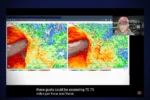Have you ever wondered how the things you use every day, like your favorite toys or snacks, get to you? A lot of them travel through a special waterway called the Panama Canal! This amazing canal connects the Pacific Ocean to the Caribbean Sea, helping ships move faster and save fuel. But there’s a problem— the weather can really affect how well the canal works. Rainfall and climate change are making it harder for ships to pass through, which could change how we get our goods in the future. Let’s dive into the world of the Panama Canal and discover why weather matters for shipping!
| Attribute | Details |
|---|---|
| Panama Canal Length | 82 kilometers (51 miles) |
| Opening Year | 1914 |
| Global Shipping Percentage | 5% of global shipping |
| Key Feature | A system of locks that raises and lowers ships 25 meters |
| Time to Traverse Locks | 8–10 hours |
| Annual Rainfall in Panama | Over 2,000 millimeters (78.7 inches) |
| Recent Dry Years | 1998, 2016, and 2024 with rainfall below 1,750mm |
| Number of Vessels in 2024 | 11,240 vessels |
| Number of Vessels in 2023 | 14,080 vessels |
| Maximum Draft Limitation | Reduced due to low water levels |
| Major Water Source | Gatun Lake, which supplies water to the locks |
| Impact of El Niño | Associated with lower rainfall in Central America |
| Future Predictions on Storms | 10% increase in storm intensity expected |
| Agua Salud Project | Studies forest cover to manage water levels |
| Current Water Levels (2025) | Highest in the past 5 years |
Impact of Climate Change on Panama Canal Operations
The Panama Canal is a crucial shipping route that connects the Pacific Ocean with the Caribbean Sea, but climate change is creating challenges for its operation. Weather patterns are shifting, leading to periods of extreme dryness that affect the water levels in Gatun Lake, a vital part of the canal’s infrastructure. When rainfall is low, the canal authority must limit the number of ships passing through, which can slow down global shipping and create delays for businesses and consumers alike.
Additionally, as the planet warms, scientists are seeing more intense storms that could lead to heavy rainfall, causing other issues. For instance, in 2010, heavy rains caused the canal to shut down completely due to rising water levels threatening an earthen dam. Such fluctuations in weather can disrupt the delicate balance needed for the canal to function smoothly, highlighting the importance of understanding climate impacts on this key trade route.
The Role of Gatun Lake in Shipping
Gatun Lake is essential for the safe navigation of ships through the Panama Canal. It provides the water needed to operate the locks that lift and lower vessels as they pass through the canal. The lake is designed to hold enough water to accommodate the largest ships, known as Neopanamax vessels, which can carry thousands of containers. However, if the lake’s water level drops too low, ships may run aground, leading to delays and increased costs for shipping companies.
To maintain healthy water levels, the canal relies on consistent rainfall throughout the year. However, recent dry years have challenged this balance, resulting in reduced shipping traffic and the need for ships to carry lighter loads. This not only affects the shipping industry but also has broader implications for global trade, emphasizing the need for effective water management strategies to ensure the canal remains functional despite changing weather patterns.
Future Strategies for Canal Management
As climate change continues to impact weather patterns, the Panama Canal Authority is exploring new strategies to manage water levels in Gatun Lake. Projects like the Agua Salud Project focus on preserving forest cover in the canal’s watershed. Forests help absorb rainfall and release water gradually, stabilizing the lake’s levels over time. By investing in these environmental initiatives, the canal can better withstand periods of drought and heavy rainfall.
Looking ahead, it is crucial for the canal’s management to adapt to these changes. This means monitoring weather patterns more closely and preparing for potential future challenges. With proactive measures, such as improving forest health and understanding water dynamics, the Panama Canal can continue to serve as a vital artery for global trade, ensuring that ships can pass through without significant delays.
The Impact of Climate Change on Panama Canal Operations
Climate change is increasingly influencing the operational efficiency of the Panama Canal. The fluctuations in rainfall patterns, which are becoming more erratic, directly affect Gatun Lake levels, a crucial water source for the canal’s locks. As the lake’s water levels drop, the Panama Canal Authority is forced to implement restrictions on vessel drafts, resulting in longer shipping delays and increased operational costs. This unpredictability poses significant challenges for shipping companies that rely on timely canal transit for global trade.
Moreover, the rising temperatures associated with climate change can exacerbate evaporation rates, further diminishing water availability in Gatun Lake. This scenario not only threatens the canal’s operational capacity but also raises concerns about the long-term sustainability of this vital shipping route. As weather patterns continue to shift, the canal’s management must develop adaptive strategies to mitigate these impacts, ensuring that it remains a robust link in global logistics.
Adapting Infrastructure for Future Weather Challenges
To combat the challenges posed by changing weather patterns, enhancing the infrastructure surrounding the Panama Canal is essential. This includes investing in advanced hydrological monitoring systems that can provide real-time data on water levels and rainfall forecasts. Such technology would enable canal authorities to make informed decisions and implement timely interventions to manage water resources effectively, thereby minimizing disruptions to shipping traffic.
Additionally, initiatives like the Agua Salud Project are crucial in restoring and preserving forest cover in the watershed area. Healthy forests play a vital role in regulating water flow and maintaining the ecological balance of the region. By enhancing these natural systems, the Panama Canal can better adapt to extreme weather events, ensuring a more resilient infrastructure capable of withstanding the impacts of climate change.
The Role of Global Shipping in Climate Adaptation
The global shipping industry plays a crucial role in adapting to climate challenges that impact the Panama Canal. Shipping companies must prioritize sustainability by adopting eco-friendly practices that reduce their carbon footprint. This includes investing in energy-efficient vessels and exploring alternative fuels that produce fewer emissions. Such efforts not only help mitigate climate change but also ensure that the industry remains viable amidst the uncertainties posed by weather variability.
Furthermore, collaboration among stakeholders—including shipping companies, canal authorities, and environmental organizations—is essential for developing comprehensive strategies to address climate-related risks. By sharing knowledge and resources, the shipping community can enhance its resilience to climate impacts, ensuring the continued importance of the Panama Canal as a key artery for global trade.
Navigating the Future: Strategies for Resilience
As the Panama Canal faces increasing weather-related challenges, developing strategic resilience plans becomes paramount. This involves not only improving infrastructure but also engaging in proactive water management practices to ensure consistent lake levels. By implementing sustainable water usage policies and investing in rainwater harvesting techniques, the canal can maintain its operational capacity even during dry spells.
Moreover, fostering partnerships with scientific communities and climate experts will provide valuable insights into weather forecasting and environmental monitoring. These collaborations can inform decision-making processes, enabling the Panama Canal Authority to anticipate changes and adapt its operations accordingly. Through these strategic initiatives, the canal can continue to thrive as a critical hub in global logistics.
Frequently Asked Questions
What is the Panama Canal and why is it important for shipping?
The **Panama Canal** is a man-made waterway that connects the **Pacific Ocean** to the **Caribbean Sea**. It is crucial because it saves ships time and fuel by allowing them to avoid the longer route around South America.
How do ships move through the Panama Canal?
Ships pass through the canal using a system of **locks**. These locks raise and lower ships about **25 meters** in elevation, making it easier for them to travel between different water levels.
What happens if there is not enough rain for the Panama Canal?
If it doesn’t rain enough, the **Gatun Lake** can get too low. This means fewer ships can pass through, and some may have to carry less cargo, causing delays in shipping.
How does climate change affect the Panama Canal?
**Climate change** can lead to more extreme weather, like heavy rains or droughts. These changes can disrupt shipping by affecting water levels in the canal and making operations harder.
What is the role of forests in the Panama Canal area?
Forests act like **sponges**, soaking up rain and releasing it slowly. This helps keep water levels in Gatun Lake stable, which is important for the canal’s operation.
What is El Niño and how does it impact the Panama Canal?
**El Niño** is a climate pattern that causes warmer ocean waters, which can lead to less rain in Central America. This affects the canal by reducing water levels when it happens.
Why was the Panama Canal shut down in 2010?
In **2010**, the canal was shut down due to record rainfall that caused Gatun Lake to rise dangerously high, threatening to overflow and damage the dam.
Summary
The content addresses the challenges faced by the Panama Canal due to regional weather variability and climate change. Key points include the canal’s vital role in global shipping, handling about 5% of worldwide trade. Recent dry years have led to reduced vessel traffic and operational limits to maintain safe water levels in Gatun Lake. Factors like El Niño have influenced rainfall patterns, affecting canal operations. Additionally, increased storm intensity due to climate change poses further risks. The importance of forest cover in managing water levels is emphasized, along with optimism for improved conditions in the coming year.







